How to Prepare an Individual Income Tax Return: A Step-by-Step Guide
“How do I prepare my own tax return?” is a common question among payers. This guide will walk you through the steps of preparing your individual income tax return, whether you choose to do it yourself or leverage the expertise of a CPA. At Elder Hanson & Company, Ltd., our team of experienced CPAs in Naperville, IL, is here should you choose to hire a CPA firm to prepare your income tax return.
How Do I File My Income Tax Return Step by Step? Tax Preparation Checklist
Filing individual income tax returns doesn’t have to be a source of stress as long as you know how to handle the filing process. Here’s a tax preparation checklist that details nine steps to prepare your income tax return:
Step 1. Keep Track of Your Income Throughout the Year
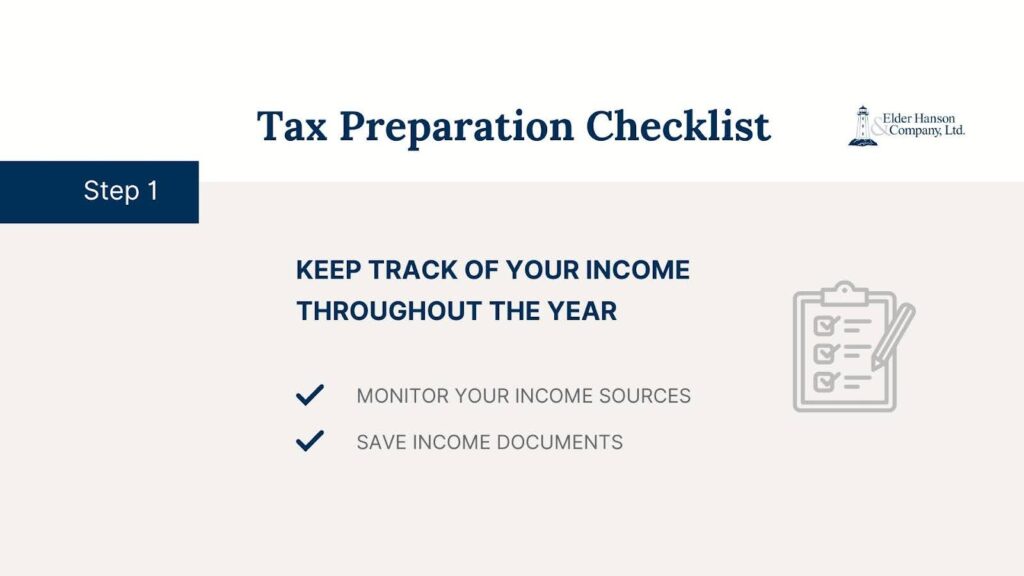
The foundation of a smooth tax filing experience is staying organized with your income records. Here’s what you can do:
- Monitor Your Income Sources: Track all your income sources throughout the year. This includes wages and salaries, self-employment income, interest income, dividend income, unemployment benefits, and any other taxable income you received.
- Save Income Documents: Don’t throw away any documents related to your income as these documents will be crucial when it comes to filing your tax return. Important documents to keep include pay stubs, W-2 forms (from employers), 1099 forms (from other income sources), and any documentation of income deductions or credits you plan to claim.
Step 2. Gather Your Tax Documents
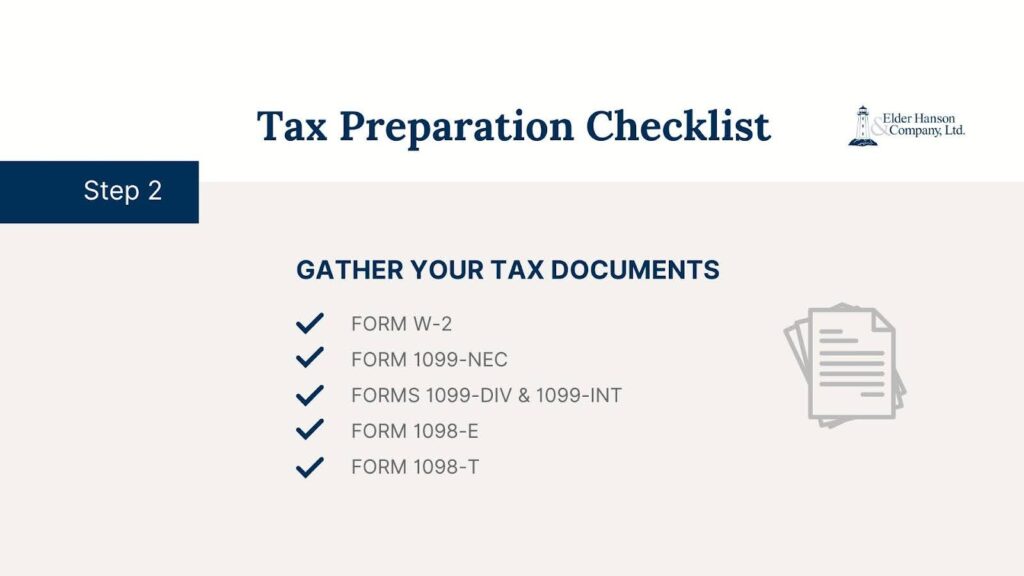
Typically, by the end of January or early February, you’ll start receiving tax documents from your employers, banks, and other institutions that paid you during the previous year. Here are key forms to look out for:
| Form Title | What Is Reported |
| W-2 | Your wages, salaries, and federal income taxes withheld by your employer(s) |
| 1099-NEC | Income you received from freelance work or self-employment |
| 1099-DIV & 1099-INT | Dividend and interest income you received from investments |
| 1099-B | Proceeds from the sale of stocks, bonds, or other investment assets; capital gains or losses on your investments |
| 1099-K | Payment card and third-party network transactions you received from things like online sales or payment settlement companies |
| 1099-MISC | Miscellaneous income not reported on other 1099 forms |
| Schedule K-1 | Share of the income, deductions, and credits from a partnership, S corporation, trust, or estate you own |
| 1098 | Mortgage interest and mortgage insurance premiums |
| 1098-E | Student loan interest you paid during the year (may qualify for a deduction) |
| 1098-T | Tuition payments made for higher education (may qualify for a deduction) |
| 1040 Schedule C | Profit or loss from a business you own and operate (sole proprietorship) |
Important Note: Don’t file your tax return until you’ve received all your income documents, especially Forms W-2 and 1099s. These forms will be used to report your income on your tax return (typically Form 1040 for federal taxes).
Step 3. Understand Tax Credits and Deductions
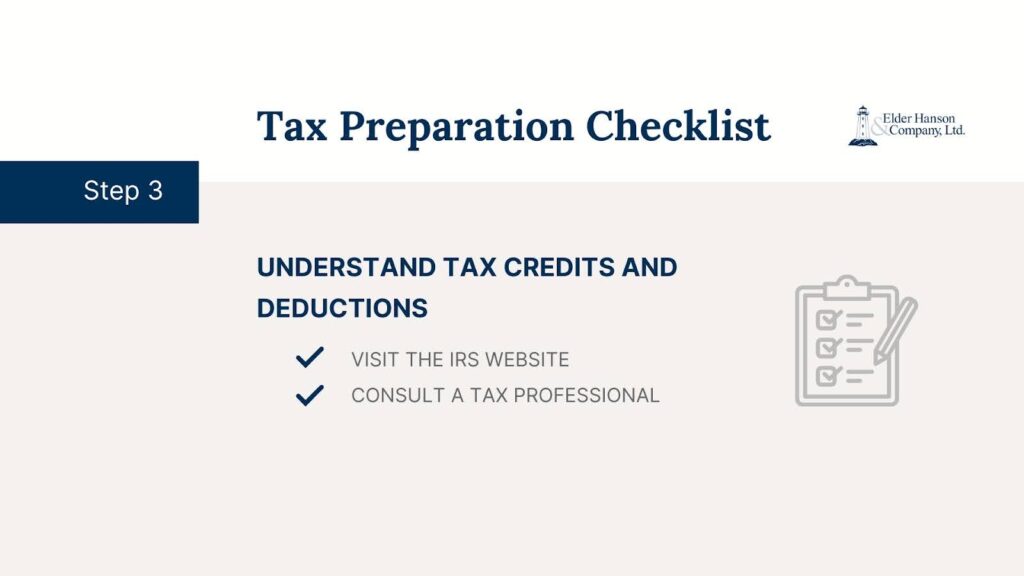
Tax credits and deductions can significantly reduce your taxable income. One important concept to understand in this context is Adjusted Gross Income (AGI). This refers to your total income minus certain allowable deductions, like student loan interest or contributions to retirement accounts. Knowing your AGI is crucial because it affects the eligibility and amount of certain deductions and credits you can claim. Here are some resources to help you identify credits and deductions you may qualify for:
- IRS Website: The IRS website provides a wealth of information on tax credits and deductions.
- Tax Professional: Hiring a tax professional to prepare your tax return, such as a Certified Public Accountant (CPA) at Elder Hanson & Company, Ltd., can help you identify credits and deductions that you might miss on your own.
Step 4. Organize Your Deductions and Credits
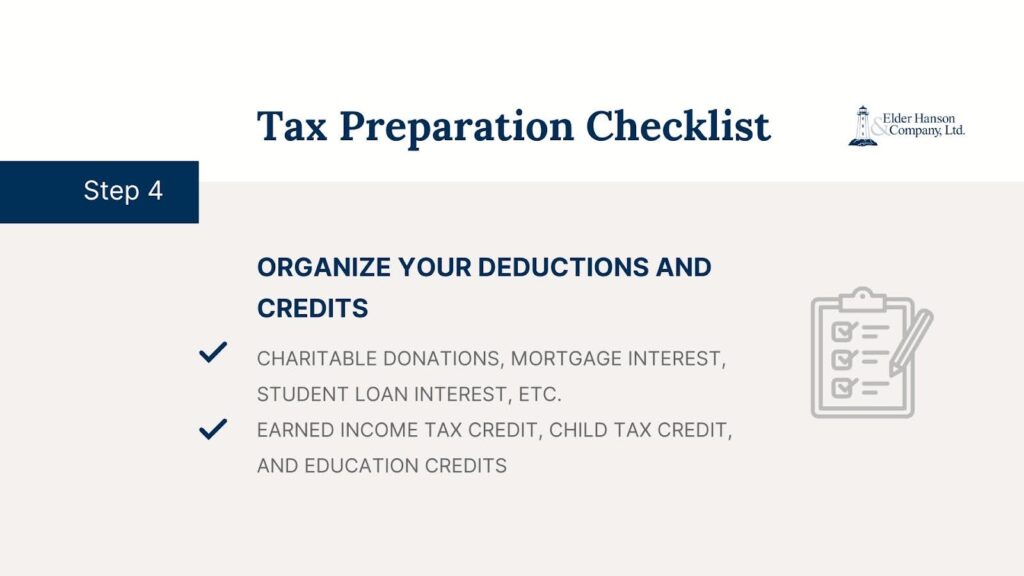
Another important step is to gather receipts, canceled checks, and other documentation to support any deductions or credits you plan to claim. Common deductions include charitable donations, mortgage interest, and student loan interest. Common credits include the earned income tax credit, child tax credit, and education credits.
Step 5. Choose a Filing Method
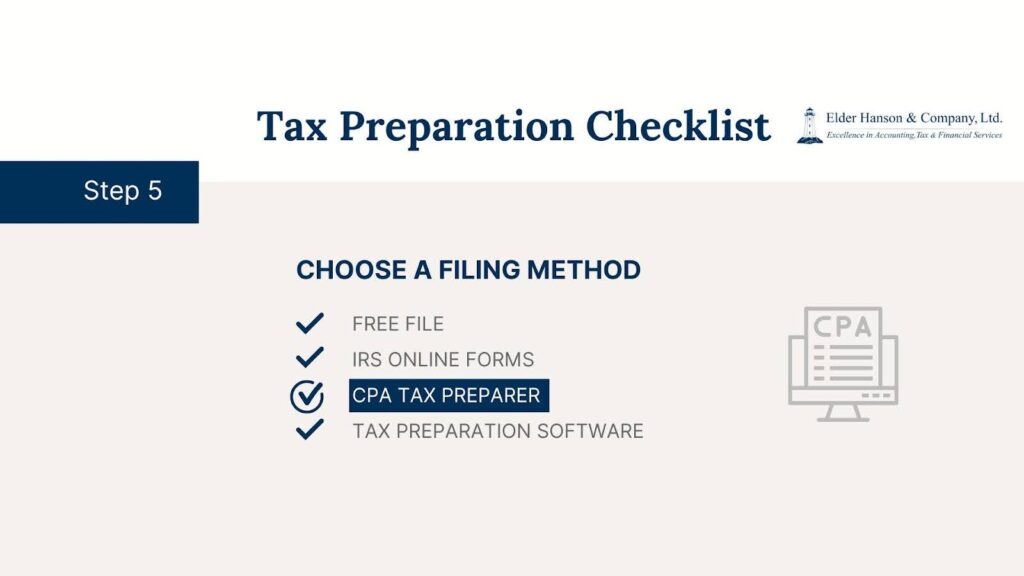
There are several ways to file your tax return:
|
Filing Method |
Description |
|
Free File |
The IRS Free File program offers free tax preparation software for low- and moderate-income filers. |
|
IRS Online Forms |
The IRS website also allows you to file your tax return electronically for free using their online forms. However, this option can be more complex and may not be ideal for everyone. |
|
CPA Tax Preparer |
Outsourcing tax returns to a certified professional accountant is often the best solution for more involved or complex tax situations. CPAs have the expertise and knowledge to ensure your return is filed accurately and efficiently, potentially saving you money in the long run. |
|
Tax Preparation Software |
It can be a good option for individuals with simpler tax situations. These programs can guide you through the filing process and help you calculate your tax liability. |
Important Note: In addition to your federal income tax return, you may also need to file state and/or local ones. Be sure to research the specific requirements in your area. In Illinois, you also file Form IL-1040.
Step 6. Review Your Return Carefully
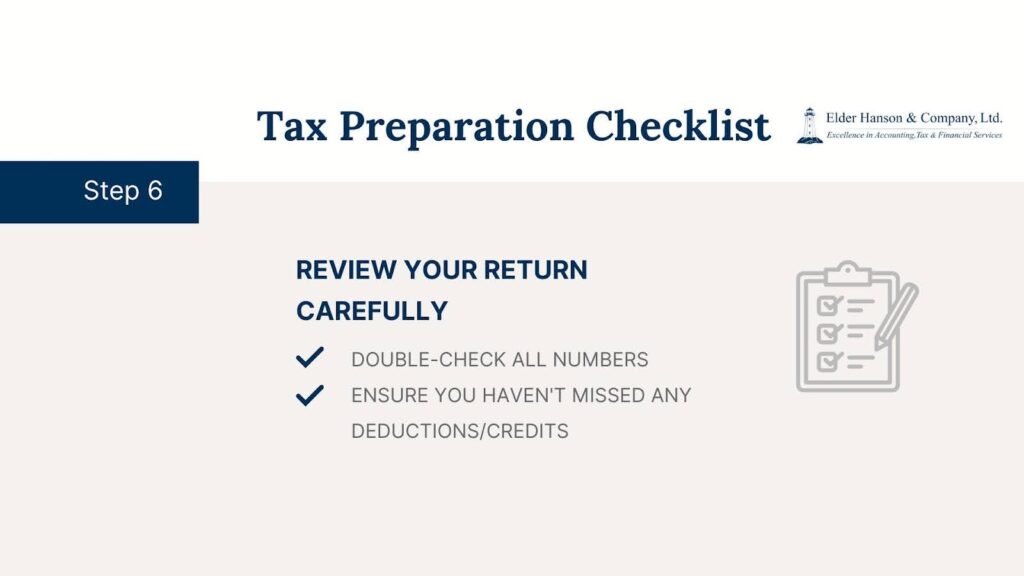
Before submitting your return, thoroughly review it for accuracy. Double-check all numbers and make sure you haven’t missed any deductions or credits.
Streamline Your Tax Filing with Expert Guidance
Minimize errors and maximize your refund in Naperville, IL, with our CPAs for individuals and small businesses.
Step 7. Meet Tax Deadlines
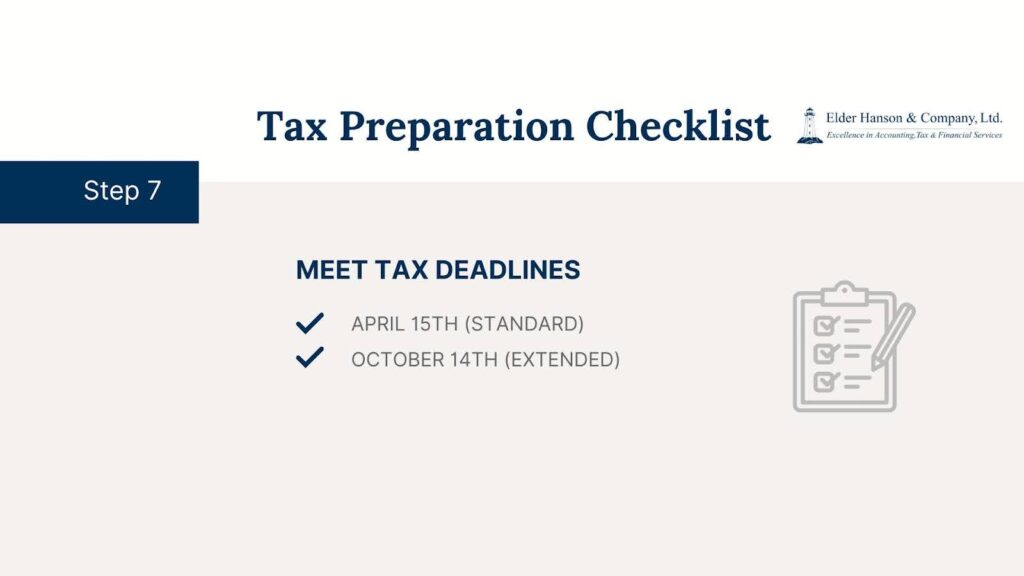
Submit your return by the filing deadline. The federal income tax deadline is typically April 15th of each year. However, you can get an extension if needed. It’s important to be aware of both federal and state tax deadlines, as some states may have different filing due dates. In Illinois, the individual tax filing deadline is typically the same as the federal filing deadline.
Important Note: An extension typically grants an additional six months to submit it (usually by October 15th). This extension applies only to the filing of the tax return, but it does not extend the time period to make tax payments if taxes are owed. If you owe money to the IRS, you’ll still need to pay the estimated amount by April 15th to avoid penalties and interest. If you can’t afford the full payment by then, the IRS offers payment plans to help you manage your tax liability.
Step 8. Pay All the Taxes Owed
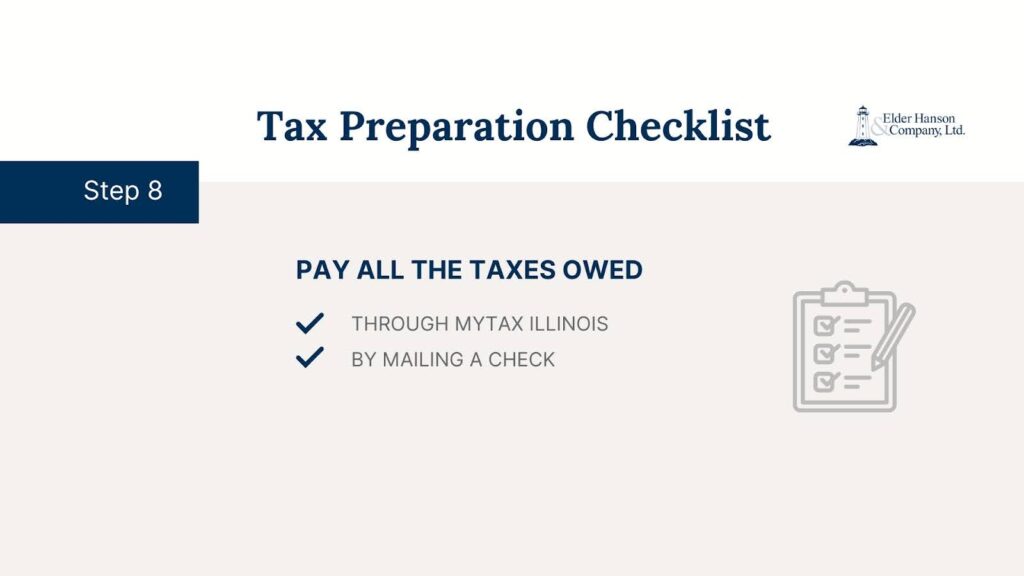
If you owe taxes, make sure to pay them by the deadline to avoid penalties and interest charges. You can pay electronically or by mailing a check.
A convenient way to file an original IL-1040 is through the MyTax Illinois platform. You’re eligible to do so if:
- This is your first time filing an Illinois tax return for this year;
- You filed an IL-1040 for the prior tax year;
- You have a Social Security Number (SSN) or Individual Taxpayer Identification Number (ITIN);
- You have a working email address;
- You lived in Illinois for the entire year;
- You only have income from wages or salaries (already reported to the state);
- You don’t have any complex deductions or credits to claim (like business expenses or investment income);
- You don’t owe any additional taxes or have any significant refunds;
- You’re only claiming your AGI and tax-exempt interest from your federal return;
- You’re claiming social security income, retirement income, Illinois income tax overpayment, military pay, U.S. interest, and contributions to a 529 plan; but not any other subtractions;
- You’re claiming property tax credit or the K-12 education expense credit, but not any other non-refundable credits;
- You’re claiming Illinois withholding taxes reported on your W-2, W-2G, 1099-G, 1099-INT, or 1099-R forms, estimated payments, and the Earned Income Credit; but not any other payments or refundable credits.
One important factor affecting your tax return is your filing status. This refers to your marital status on the last day of the year (December 31st) and determines your tax rates and eligibility for certain deductions and credits. Common filing statuses include single, married filing jointly, married filing separately, and head of household.
Step 9. Keep Copies of Your Return
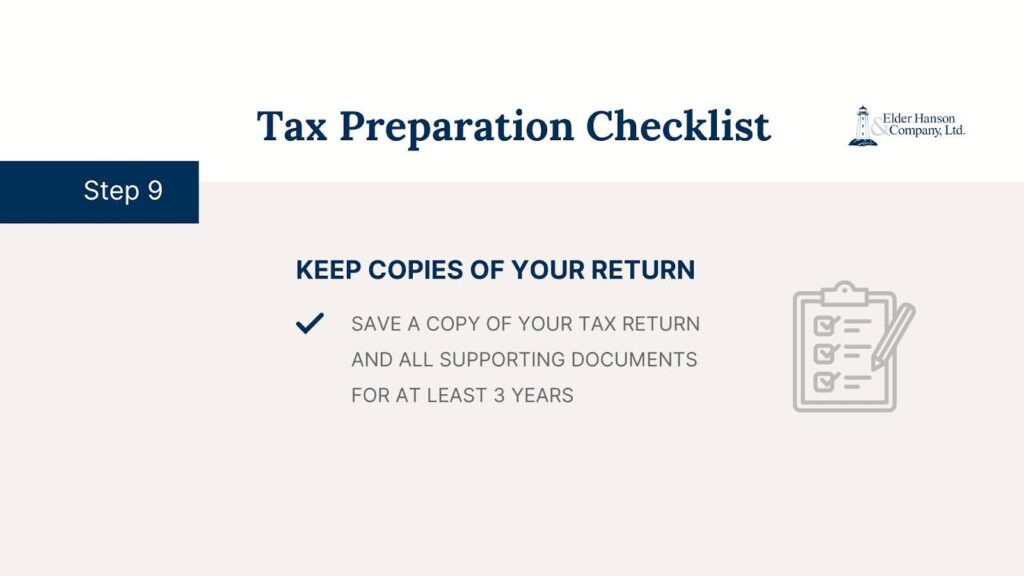
Make sure to save a copy of your tax return and all supporting documents for at least three years.
Tax Preparation with Elder Hanson & Company, Ltd.
Don’t let tax season add unnecessary stress to your life. Contact us today to schedule a consultation with one of our experienced CPAs in Naperville, IL. If you choose to hire us, we’ll answer your questions, discuss your tax situation, and help you choose the filing option that’s right for you. Let us help you navigate the complexities of tax filing and potentially save you money!
FAQ
What shall I do if I already submitted form IL-1040?
There’s no need to send it again. Filing multiple copies can slow down processing.
Where can I check the status of my IL refund?
To find out if your return has been received and if the refund process has begun, visit Where’s My Refund? by the Illinois Department of Revenue (IDOR). If the IDOR has finished processing your return, use the Illinois Comptroller’s Find Your Illinois Tax Refund System.
Can I amend the form IL-1040 I filed?
If you made a mistake or forgot to add something, you can file Form IL-1040-X – Amended Individual Income Tax Return.
How should I respond to a Return Correction Notice (RCN)?
Do not file a new IL-1040; instead respond directly to RCN, if you have verified that the notice is authentic, and follow their instructions.
How can I file a prior year form IL-1040?
You can file an original Form IL-1040 for tax years 2012 through 2022 through your MyTax Illinois account.
E-File vs. paper tax filing: which is better?
E-filing your taxes is the fastest and most secure way to submit your return. Filing by mail means waiting for processing, risking delays, and potentially exposing yourself to mail loss or identity theft.
How much does tax preparation cost?
Tax preparation costs vary depending on your tax situation’s complexity, the kind of specialist you need, and how your taxes are organized.